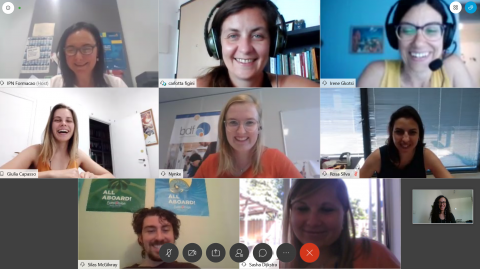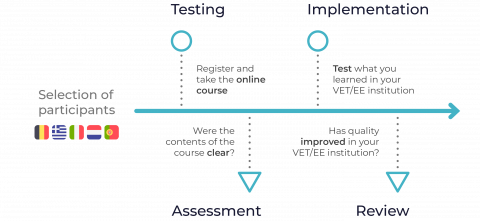2.8 - Design of the Training Methodology
Abstract
The training methodology deals with the methods aimed to design and implement training. To be
able to identify and correctly implement the training method best suited to the goal of the
Training Course is a fundamental step in the quality management of an organization. As Quality
Manager you should appoint a responsible person in charge to study and research the best suited
training methodologies that exist, and to adapt them to the specific needs of his/her organization.
In the planning phase, as a Quality Manager you should dedicate an appropriate time and space to
the decision on the best Training Methodology to apply to each situation. Moreover, you should
be constantly monitoring the results of the applied methodologies through interviews and
questionnaires, and through analysis of whether the goals were reached and what the strengths
and weaknesses of the specific methodology applied are.
Why is this important for you as a QM?
- To be involved in the process of decision making, since these decisions have a huge impact on the whole organization and are a decisive factor on the quality of the Course and training
- To guarantee that the decisions will be made while taking into consideration the results of the previous evaluation done during or at the end of previous training courses
- To ensure that the proposed methodologies will be tailored to the actual needs of the students, and can be modified based on the feedback received and on their effectiveness
How should I implement the action?
To be able to choose the best training methodology for your organization, you need to know the
updated didactical studies and innovative teaching methods
- Appoint, in the training team, someone dedicated to studying and researching, so as to always be able to have an insight into the most innovative practices
- Keep in mind these elements when researching the best training methodology to apply to a specific course: the goal of the course, the learning outcomes (LO), the target audience, eventual time constraints, and the subject taught
- Based on these features, choose the best way to deliver training. For example, possible choices could be between:
- Classroom Frontal Learning: Classrooms are used when large groups must be taught the same thing at the same time or the task difficulty requires formal training. Classroom settings permit the use of a wide variety of training methods, e.g. video, lecture, simulation, and discussion. Also, the environment, such as seating arrangements, can be controlled to create a climate conducive to learning and classrooms can accommodate a large number of learners. It is, however, usually one of the most costly methods.
- Distance Learning: We can talk of distance learning whenever students are not physically present in a classroom together with the teacher. It can be divided into two modes of delivery: synchronous learning and asynchronous learning. In synchronous learning, all participants are “present” at the same time. In this regard, it resembles traditional classroom teaching methods despite the participants being located remotely. In asynchronous learning, participants access course materials flexibly on their own schedules.
- Blended learning: is a formal education program in which a student learns at least in part through delivery of content and instruction via digital and online media with some element of student control over time, place, path, or pace
How should I know if I have made an impact thus increasing the quality of the VET provision and to which extent?
- The feedback received from the students at the end of the course shows that the students are satisfied with the training method used to deliver the course:
- They believe is the right method to deliver a course on the specific subject
- They believe it was the right method for them
- They would not have preferred to be able to follow the course with another method
The feedback received from the teachers themselves at the end of the course show that they believe it was the right method for the subject (self-assessment).
The participation rate of the programme is increased thanks to the choice of the best suited training methodology, as measured by the EQAVET Indicator n.3
The completion rate of the programme is increased thanks to the choice of the best suited training methodology, as measured by the EQAVET Indicator n.4
Links & further readings
- European Union Agency for Network and Information Security 2014, Good Practice Guide on Training Methodologies [https://www.enisa.europa.eu/publications/good-practice-guide-on-training-methodologies/at_download/fullReport] Last accessed 30/03/2020
- CEDEFOP, Using Learning Outcomes, European Qualifications Framework Series: Note 4, 2011 [https://www.cedefop.europa.eu/files/Using_learning_outcomes.pdf] Last accessed 30/03/2020
- Lifelong Learning Platform, 21st Century Learning Environments (2019)



